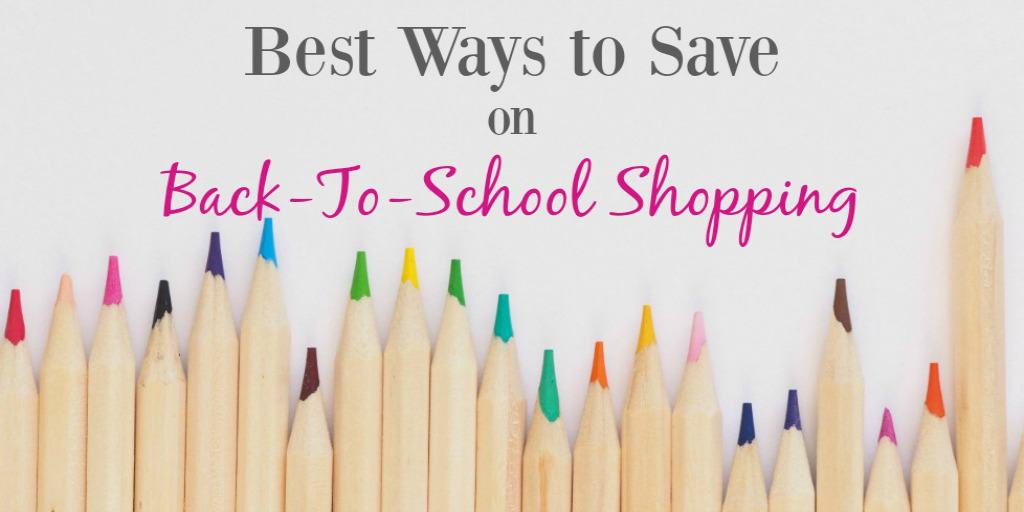Best Ways to Save on Back-to-School Shopping
(This page may contain affiliate links and we may earn fees from qualifying purchases at no additional cost to you. See our Disclosure for more info.)
While we haven’t put the pandemic behind us yet, students all over the country are heading back to school this fall. And that means many parents have back-to-school shopping lists in hand.
Back-to-school shopping is one of the biggest retail seasons of the year, according to the National Retail Federation (NRF). In addition to winter holiday spending (#2), back-to-college and back-to-school are predicted to be the number 1 and 3 top spending events (average spend expected per person) in 2021.
While some students are starting school fully online or with hybrid in-school and distance learning plans, many will be back in the classroom this fall.
Last year, the focus for many students was to have supplies and equipment preparing them to learn from home. But store aisles are once again filled with glue sticks, folders, backpacks, and the latest fashions for kids.
And after a very challenging year, shopping for school clothes and supplies can put a significant strain on personal budgets too.
That’s why it’s important to carefully consider your back-to-school shopping needs and how it impacts your finances.
Students may need some supplies and clothes to begin the year, but there are ways to save and cut back on back-to-school spending if money is tight.
Also, many communities offer support for growing numbers of families who need help preparing for back-to-school.

Back-To-School Shopping is REALLY Big Business
While the winter holidays are in the top 3 of average planned spending, back-to-college and back-to-school shopping now rank 1st and 3rd in the Top 5 consumer spending events.
According to the National Retail Federation (NRF), back-to-school spending could reach a new record of $37.1 billion in 2021 – up from last year’s all-time high of $33.9 billion.
Parents with kids in kindergarten through high school, plan to spend close to $850 per family to prepare for the school year.
The results from the June 2021 Back-To-School (B2S) Survey by Deloitte also project a 16% increase in spending over last year. Here are some interesting takeaways from their survey:
- Unsurprisingly, online-only shopping continues to rise in popularity (up 5% to a total of 49% of respondents)
- Even with a return to the classroom, digital learning tools are driving sales up 37%
- The COVID-19 spending category has also shown an increase for 2021 (examples include sanitizer products, furniture and equipment for virtual learning)
With many families continuing to live paycheck-to-paycheck, and others holding tight to their budgets, it’s essential to look at ways to save money, getting the kids ready to head back to learning.
Sales Tax Holiday Incentives
Special Sales Tax Holidays focusing on back-to-school purchases have been announced for 2021.
States participating include:
| Alabama | Maryland | Ohio | Virginia |
| Arkansas | Massachusetts | Oklahoma | West Virginia |
| Connecticut | Mississippi | South Carolina | |
| Florida | Missouri | Tennessee | |
| Iowa | New Mexico | Texas |
To learn more, check out this chart on Wallethub. It shows how much tax you’ll save, items covered by the sales (and exceptions), and the dates of your state’s sales tax holiday.
Invest Time Before You Spend Money on Back-to-School Shopping
Before you grab the lists of supplies to do school shopping, take some time reviewing what you have at home.
This can be an excellent way to save money.
Clothes, Shoes, and Accessories
Going through your kids’ dressers and closets can really pay off. Getting new school clothes has turned into a huge business when many kids already have plenty to wear.
It’s not that you shouldn’t buy your kids a new outfit or pair of sneakers for school. But unless they’ve grown out of everything – a new wardrobe is usually not necessary.
If kids are learning from home or only in school part-time, their clothing needs will likely be different from typical school years too.
Use What They Have
Whatever your kids wore at the end of last school year may still fit for the first month or two of the new school year.
The shorts and t-shirts they wore at home when schools closed were fine in April and May, so wearing the same ones to start the year makes sense.
If they need new pants or sweaters, wait until colder fall weather arrives before buying your growing child’s new clothes.
The same goes for their backpack, lunch bag, and other accessories if they attend school in-person this fall.
A new school year doesn’t mean everything needs to be new.
If your child complains that “all the other kids are getting new things” – having a money conversation about needs and wants and working to earn money to buy things might be the cure.
When They Need New
When your child does need new clothes, shoes, or a backpack for school, make a specific list of their needs. Then save money on back-to-school shopping by sticking to that list when you shop.
Before going online or to a store, check with your family or friends with children who may have outgrown clothes. Swap too small clothing for your kids with others who are looking.
You can then look online at sites like eBay, OfferUp, or Facebook Marketplace, and in neighborhood groups like Nextdoor. You may find large sets of clothing offered by sellers called lots.
If the clothes are in good condition, this can be a great way to save money and time. Another bonus? You’ll get a lot of shopping done all in one place.
Consignment shops, thrift stores, and garage sales are other good places to shop. Kids grow so fast that you may find some clothes with tags still on them or others very gently used.
If you have an active Freecycle group near you, there may be people giving away clothing they no longer need there as well.
When you head to a department store or mall for your back-to-school shopping, there are ways to save money. Just remember to stick to your list!
Some stores mail coupons home or have them online, and you can often stack them on sale prices in stores to save even more. If you use a cashback or rewards credit card and pay it off at the end of the month, you’ll save extra.
You can also try picking up a discounted gift card for your favorite store at Raise or Gift Card Granny. Saving an extra 5-10% at some popular stores makes it worth a look!
And many stores offer better deals online. But before you start searching, don’t forget to click through a cashback site like BeFrugal or Rakuten to boost your savings.
Here's our review on BeFrugal
One last thing to consider is a few companies like Jansport offer a lifetime warranty on purchases like backpacks. They may cost more upfront, but if they get used for years, it’ll pay off in the end.
Back-to-School Supplies

Most schools ask parents to provide some supplies for their kids to use at school. If you don’t have the list yet, check your school’s website or wait until the first day of school.
The lists may look very different depending on what grade students are in and may include things you haven’t predicted. And this year, many schools are delaying sending or posting supply lists because the return to school plans are still not finalized.
Use What They Have
This is another case where looking around your home before you shop can save money. Go through desk and junk drawers, craft supplies, and your pantry to see what you can cross off your list.
Buying packages of pens and pencils when you have dozens at home doesn’t make sense. It may only be a few dollars an item, but it all adds up.
When They Need New
Many big-box merchants, office supply stores, and drug stores offer significant discounts for necessary school supplies. If you think it’s worth your time for smaller items, use store sale flyers or apps like ShopSavvy to look for the lowest prices.
You can also head to a Dollar Store near you to see what inexpensive things you can find. Just remember that the quality of those items varies. Some are great bargains, and others may not be worth the savings.
Wait until the first week of school is over to do your back-to-school shopping, and choices might be limited. But the prices of any remaining items will be slashed as school supplies become clearance items, and Halloween decorations take their place.
This is an excellent time to pick up items your kids use each year for a fraction of the usual (even discounted) price.
The same discounted gift cards and cashback sites you use for clothes can also work for many school supplies. Just remember that a few extra clicks can save you even more money.
Computers, Hardware, & Electronic Gadgets
When bigger-ticket items like laptops or graphing calculators are on your back-to-school shopping list, use apps and services to help find the lowest prices.
But make sure you check with the school to see if there’s a specific item/brand needed in a course your child is enrolled in before you spend money on these items.
Many schools use 1:1 electronic devices with their students and provide the equipment. In this case, buying a laptop or tablet might not make sense.
If you decide to purchase electronics, the cashback sites, discounted gift cards, and rewards credit cards – along with back-to-school prices can help you save big on these expensive items.
Spend Less as You Gear Up for Back-to-School
If spending several hundred dollars on back-to-school shopping is the average for families – some are spending a lot more, and others much less.
Using some tips discussed here can lower costs to help you save money and start the school year off right.
It might make sense to stick to the basics and purchase other supplies and clothes as schools return to in-person learning.
Helping Others too
If you’re able, consider donating to those in need. There are plenty of parents struggling with money who can’t afford supplies or new clothing for their children.
Your school district or local community organizations may have a “stuff the bus” week to collect school supplies or a “clothing closet” taking donations of new and used clothes.
Cash donations are often accepted to purchase additional supplies for families in need as well.
Check with your school to see how you can help those who are less fortunate than you.

Written by Women Who Money Cofounders Vicki Cook and Amy Blacklock.
Amy and Vicki are the coauthors of Estate Planning 101, From Avoiding Probate and Assessing Assets to Establishing Directives and Understanding Taxes, Your Essential Primer to Estate Planning, from Adams Media.

